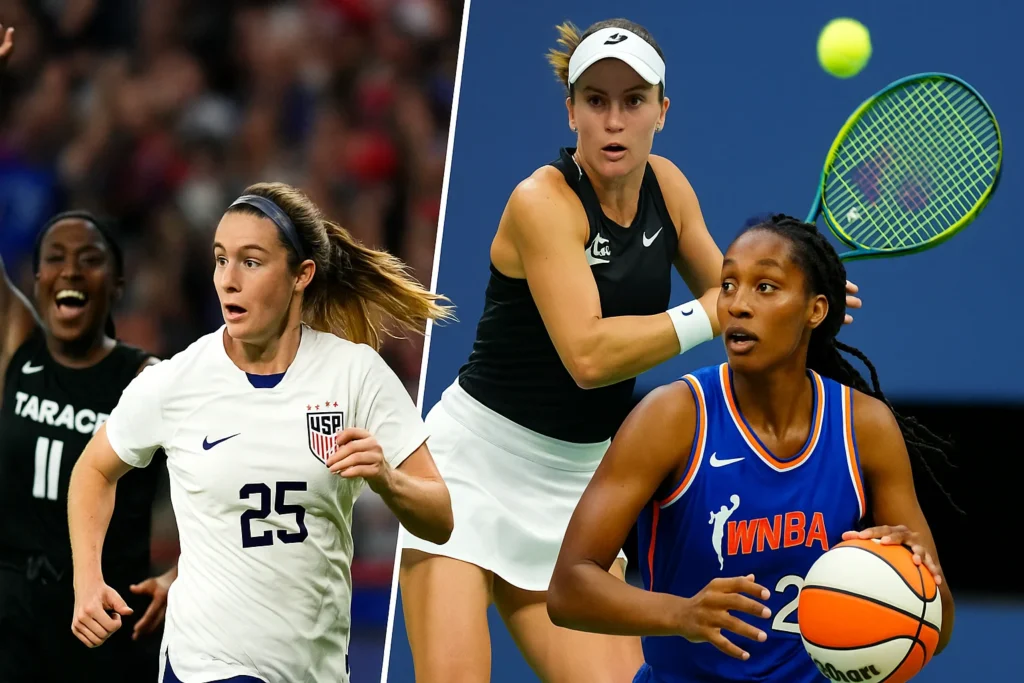Introduction: The Roar of the Crowd Grows Louder
For generations, women’s sports have often been an afterthought, tucked away in the back pages of newspapers or relegated to late-night TV slots. But something extraordinary has been happening. In 2025, the quiet revolution has become an undeniable roar. We are witnessing an explosive surge in popularity, investment, and global reach for women’s athletics. From packed stadiums for the NCAA women’s finals to groundbreaking new sponsorship deals, a wave of change is sweeping across the sporting world.
This isn’t just about a few standout moments; it’s a deep and lasting shift in how female athletes are viewed, valued, and celebrated. Major brands are pouring money into women’s leagues, viewership numbers are shattering records, and the athletes themselves are becoming household names, building powerful brands both on and off the field. This article will explore this monumental shift, looking at the milestones achieved, the money being invested, the voices leading the charge, and the cultural transformation that promises a bright future for women in sports.
Viewership Milestones: The Screens Are Lighting Up
If you wanted proof that women’s sports are captivating audiences, you only need to look at the viewership numbers in 2024 and 2025. The story isn’t just about growth; it’s about setting new benchmarks and establishing women’s sports as must-watch events.
Record-Breaking Moments
- NCAA Women’s Basketball Finals: The 2024 NCAA Women’s Basketball Championship game became a television phenomenon, drawing an incredible 18.9 million viewers. This wasn’t just a record for women’s basketball; it outdrew the men’s final, a remarkable achievement that highlighted the star power and exciting play on display. While the 2025 final, featuring UConn and South Carolina, saw fewer viewers at 8.5 million, it still ranked as the third most-watched women’s championship game ever. This shows that the 2024 number wasn’t a fluke; it set a new, much higher bar for regular viewership expectations.
- WNBA Growth: The WNBA growth in 2025 continued its upward trend, building on the excitement generated by phenomenal rookie classes and established stars. The 2025 WNBA Draft, for instance, attracted an average of 1.25 million viewers, making it the second most-watched draft in the league’s history. Regular season games are consistently drawing larger audiences, and social media engagement is through the roof.
- International Soccer Leagues: While the big news for 2025 is the men’s FIFA Club World Cup, the ripple effect of the highly successful 2023 FIFA Women’s World Cup continues to boost women’s soccer globally. Leagues around the world are seeing increased fan interest. In the U.S., for example, international soccer viewership as a whole grew by an astounding 60% from 2018 to 2024, with female viewership increasing in prominent leagues like Mexico’s Liga MX and Germany’s Bundesliga. This indicates a growing appetite for women’s soccer beyond major tournaments.
These viewership milestones send a clear message: people want to watch women’s sports. The compelling narratives, incredible athleticism, and fierce competition are capturing hearts and minds across the globe.
Major Deals: The Sponsorship Floodgates Have Opened
For years, women’s sports struggled to attract significant financial backing. But in 2025, that narrative has been completely flipped. Major brands, including giants in sportswear and technology, are now heavily investing, recognizing the immense value and untapped potential of female athletes and their dedicated fan bases.
Billions Being Poured In
According to projections, global revenues for women’s sports are expected to hit a staggering $2.35 billion in 2025. This represents a massive 240% increase in just four years, demonstrating the rapid acceleration of investment. Commercial sponsorships are the biggest driver of this growth, accounting for over half of all revenue.
- Sportswear Giants: Nike and Adidas are leading the charge, increasing their commitments to individual athletes and entire leagues. They see the power of female athletes as role models and influencers, not just for selling sports gear, but for shaping cultural trends.
- Tech Sponsors: The tech world is also getting in on the action. Companies like Amazon, known for its streaming ventures, are acquiring broadcast rights, as seen with the WNBA’s landmark 11-year, $2.2 billion media rights deal with Disney, Amazon, and NBCU. This deal alone ensures unprecedented visibility for the WNBA.
- Diverse Brand Partnerships: Beyond the obvious, a wide array of brands are stepping up. Companies from AXA (insurance) to Coca-Cola (a long-time FIFA Women’s World Cup sponsor), Visa, Unilever, and even food and beverage giants like Frito-Lay and PepsiCo are signing on. They recognize that women’s sports offer a unique platform to connect with diverse, engaged audiences. For example, Unilever’s recent commitment to the FIFA Women’s World Cup shows a significant embrace of women’s football on the global stage.
This influx of sponsorship money isn’t just about advertising; it’s a validation of the market potential of women’s sports, signaling that it’s a prime area for growth and return on investment.
Player Power: Rising Salaries and New Collective Bargaining Agreements
The increased attention and financial investment are directly impacting the athletes themselves, leading to higher salaries and stronger collective bargaining agreements (CBAs). While challenges remain, the trend is clear: female athletes are gaining more power and a fairer share of the revenue they help generate.
A Step Towards Fairer Compensation
- WNBA Salaries Increasing: The WNBA has been a key battleground for player compensation. The current CBA, which was put into effect in 2020, is set to expire in late 2025, and players have already opted out, signaling their intent to negotiate an even better deal. This means players are expecting significant raises and better benefits. For 2025, the WNBA’s salary cap is around $1.5 million per team, with top players earning up to $249,244 with a “supermax” contract. While these numbers are still far from their male counterparts, they represent a significant jump from previous years and are expected to grow further with the new CBA.
- Other Leagues Following Suit: This momentum isn’t limited to basketball. In soccer, for instance, while a FIFA report in early 2025 noted the average annual salary for women’s soccer players globally was still low ($10,900), it also highlighted that top-tier clubs were paying much more, and there’s a clear push for increased prize money in major tournaments.
- The Caitlin Clark Effect: The phenomenon of college stars like Caitlin Clark transitioning to the professional ranks has supercharged interest and, consequently, value. While her rookie WNBA salary of around $77,000 made headlines for its disparity compared to male top picks (like Victor Wembanyama’s $12.2 million), the broader impact is that her immense popularity is driving league revenues, which in turn fuels the arguments for higher pay for all players.
The push for better salaries and improved working conditions is a central theme in women’s sports, driven by both athlete advocacy and the undeniable economic success of the leagues.
Social Media and Influencer Crossover: Building Personal Brands
In today’s digital world, athletes are more than just performers; they are storytellers, advocates, and entrepreneurs. Social media has become an incredibly powerful tool for female athletes to connect directly with fans, build their own brands, and drive the overall popularity of their sports.
From Athletes to Icons
- Direct Engagement: Platforms like Instagram, TikTok, and X (formerly Twitter) allow athletes to share behind-the-scenes glimpses of their lives, training, and personalities. This authentic connection fosters deeper loyalty with fans than traditional media ever could.
- Controlling the Narrative: Social media empowers female athletes to shape their own stories, highlighting their athleticism, resilience, and personal values, rather than relying solely on traditional media outlets that sometimes focused more on appearance than performance.
- Influencer Power: Female athletes often boast impressive engagement rates on social media, sometimes even surpassing their male counterparts. Brands are taking notice, realizing that partnerships with these athletes offer a unique blend of athletic excellence and genuine connection, leading to highly effective marketing campaigns. For example, brands are leveraging WNBA players and Olympic medalists for record-breaking campaign results.
- Monetization Beyond the Field: Athletes are leveraging their social media presence to secure personal endorsement deals, launch their own merchandise lines, and even produce content, creating additional revenue streams independent of their league salaries. This allows them to build long-term careers and financial stability.
This direct line to fans transforms female athletes into powerful influencers, driving not only their personal brand value but also boosting the visibility and appeal of women’s sports as a whole.
Progress Toward Equal Pay: The Ongoing Fight
While the surge in viewership and sponsorships is undeniable, the fight for equal pay in women’s sports remains a critical ongoing challenge. Significant progress has been made in certain areas, but deep-rooted disparities persist, highlighting the need for continued advocacy and systemic change.
Steps Forward, Hurdles Remain
- Increased Prize Money: Major tournaments like the FIFA Women’s World Cup have seen substantial increases in prize money, moving closer to parity with men’s events, though a gap still exists. Similarly, Grand Slam tennis tournaments have achieved equal prize money.
- Player Advocacy: Athletes themselves are at the forefront of this battle, using their collective voice and public platforms to demand fair compensation. The WNBA players’ decision to opt out of their current CBA is a prime example of this sustained push for better pay and conditions.
- Visibility as a Catalyst: The increased media coverage and viewership of women’s sports directly strengthen the argument for equal pay. As revenue grows, it becomes harder for leagues and federations to justify significant pay gaps.
- Persistent Challenges: Despite the progress, major gaps remain:
- Revenue Disparity: Men’s sports still generate significantly more revenue from broadcasting deals, ticket sales, and sponsorships, creating a large pot of money from which to draw salaries. For instance, the NFL’s 2025 salary cap per team is orders of magnitude larger than the WNBA’s.
- Media Coverage Imbalance: While improving, media coverage for women’s sports still lags far behind men’s. In 2019, women’s sports accounted for only about 5.4% of airtime on live television. While this is expected to reach closer to 20% by the end of 2025, the historical disparity affects brand visibility and revenue generation.
- Investment Gap: Historically, less investment has gone into training facilities, coaching, and development programs for women’s sports, limiting opportunities and growth.
- Societal Biases: Underlying biases and traditional views that sports are “male activities” continue to affect how women’s sports are perceived and valued.
The journey to full pay equity is long, but the momentum is undeniable, with athletes and allies relentlessly pushing for a future where talent and hard work are rewarded equally, regardless of gender.
A Cultural Shift: How Female Athletes are Celebrated
Beyond the numbers, perhaps the most profound change in 2025 is the cultural shift in how female athletes are perceived, covered, and celebrated. They are no longer viewed merely as athletes but as powerful role models, activists, and cultural icons shaping societal perceptions.
From Overlooked to Icons
- Elevated Media Coverage: While not yet at parity, there’s a noticeable shift in how female athletes are covered. More stories focus on their skills, achievements, and compelling personal journeys rather than solely on their appearance or family lives. Major sports networks are dedicating more airtime and journalistic resources to women’s events.
- Role Models for a New Generation: Young girls and boys now have a plethora of female athletes to look up to. These athletes inspire not just athletic dreams but also demonstrate leadership, resilience, and advocacy, showing that women can excel at the highest levels in any field.
- Authenticity and Advocacy: Many female athletes use their platforms to champion social causes, advocate for gender equality, and speak out on important issues. This authenticity resonates deeply with fans and earns them respect beyond their sporting achievements.
- Community and Connection: Events like “Women in Sport Week,” celebrated globally, highlight female athletes and leaders. Initiatives by organizations like Sport Ireland focus on increasing visibility, coaching, and participation for women and girls at all levels, from grassroots to elite.
- Merchandise and Fandom: Walk into any sports store in 2025, and you’ll find a greater selection of jerseys and merchandise for female athletes and teams. Fan engagement extends beyond game day, with vibrant online communities celebrating their heroes.
This cultural shift is a testament to the power of persistent effort and undeniable talent. Female athletes are breaking down barriers, challenging old norms, and building a more inclusive and inspiring world of sports for everyone.
Conclusion: The Era of Women’s Sports Has Arrived
The journey of women’s sports has been one of perseverance, talent, and unwavering dedication. In 2025, the surge in women’s sports is not just a passing moment; it’s a powerful, irreversible force transforming the global sports landscape. We’ve seen record viewership for events like the NCAA Women’s Basketball Finals, unprecedented sponsorships from global giants like Nike, Adidas, and major tech players, and a clear upward trajectory in player salaries and collective bargaining power.
The impact of social media and influencer crossover has allowed female athletes to connect directly with fans and build powerful personal brands, while the ongoing fight for equal pay continues to push for systemic change, even as significant challenges remain. Most importantly, there’s a profound cultural shift underway, where female athletes are celebrated not just for their athletic prowess but as inspiring role models, advocates, and leaders.
This isn’t just about women getting a bigger piece of the pie; it’s about expanding the entire pie, making sports more vibrant, diverse, and engaging for everyone. The future of women’s sports is not just promising; it’s here, and it’s exhilarating to witness.



